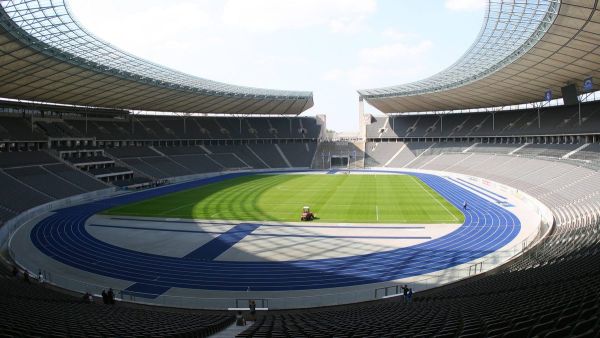

Bundesliga 2 remains among the best-supported leagues in Europe, and with a number of iconic and otherwise incredible grounds hosting its clubs, the 2025/26 season is sure to see more thrilling football played out against great backdrops. bundesliga.com runs through the grounds…
Hertha Berlin: Olympiastadion
Capacity: 74,649
Opened: 1 August 1936
One of the most instantly recognisable stadiums in world football features in Bundesliga 2. Having been opened for the 1936 Berlin Olympics, the giant stadium moved on from its original association with National Socialism to become a modern venue hosting some of football’s biggest events in recent decades. Matches at both the 1974 and 2006 World Cup were hosted there, including the final in the latter tournament as well as the Euro 2024 final, 2015 UEFA Champions League final and a grand total of 44 DFB Cup finals.
The historic venue has hosted Hertha since 1963, which was the year the Bundesliga was launched. A major renovation ahead of the 2006 World Cup gave it much of the appearance it is known for today, including its blue running track. City rivals Union Berlin used the stadium for three UEFA Champions League home matches in 2023. While Hertha sold out the stadium just once in the 2024/25 Bundesliga 2 season, attendances averaged above the 50,000 mark. Among other events at the stadium, the list of concerts to have been hosted there features countless legendary acts like the Rolling Stones, Coldplay and U2.
Schalke: Veltins-Arena
Capacity: 62,271
Opened: 13 August 2001
Known for their passionate fan base, Schalke made plans just before the turn of the century to construct a modern arena, and their ground has fully lived up to that promise in the 24 years since its opening. As well as offering a top-class experience to stadium goers, the ground is perhaps best known for the sight of players lining up in its distinctive tunnel, which was redesigned in 2014 to look like the interior of a coal mine. That is just one of the touches Schalke have used to emphasise the club’s links to the historic local mining industry.
There is no mistaking the tunnel at Schalke’s Veltins-Arena for anywhere else. – imago images / RHR-Foto
As well as being Schalke’s proud home since its opening, the Veltins-Arena has hosted matches at the 2006 World Cup and Euro 2024, in addition to the 2004 UEFA Champions League final. Schalke’s immensely loyal fanbase rarely failed to completely fill the stadium in 2024/25, with the club boasting the league’s highest average attendance of just under 62,000, despite finishing 14th. No club outside a top division anywhere in the world boasted such attendance figures. Ukraine’s Shakhtar Donetsk used the stadium as a temporary home for their 2024/25 Champions League campaign, while American pop megastar Taylor Swift performed three nights of concerts there in July 2024 as part of her Eras Tour.
Watch: Ruhr Valley – The heart of German football (part 1)
Fortuna Düsseldorf: Merkur Spielarena
Capacity: 54,600
Opened: 10 September 2004
Modern and massive would be an apt way to describe Düsseldorf’s stadium, which has a retractable roof and is found in an iconic location by the River Rhine. Fortuna drew a big average attendance of over 40,000 to the arena in 2024/25 as their bid to return to the Bundesliga ended with a sixth-placed finish. Thanks to the pioneering Fortuna for All initiative, it is one of the only grounds in world football you can get into for free for certain matches.
Watch: The Düsseldorf stadium experience
It is another Bundesliga 2 ground that has hosted numerous major events. Those include five matches at Euro 2024, boxing world title bouts, countless big concerts and the 2011 Eurovision Song Contest.
Nuremberg: Max-Morlock-Stadion
Capacity: 50,000
Opened: 1928
One of four Bundesliga 2 stadiums to have a capacity of 50,000 or more, the Max-Morlock-Stadion has a long history. Although it was built before the rise of National Socialism, it was used extensively in that era for propaganda purposes, with the massive German Combat Games held there in 1934. It was remodelled in the post-war era and again in both the late 1980s and in 2002. It is named after a former club legend and West Germany international.
The latter renovation was planned to get the stadium ready to host five matches at the 2006 World Cup. Nuremberg, who have been crowned champions of Germany nine times (once in the Bundesliga in 1967/68), averaged crowds of over 37,000 as they finished 2024/25 in mid-table (10th).
Kaiserslautern: Fritz-Walter-Stadion
Capacity: 49,350
Opened: 13 May 1920
Few locations in German football are as steeped in history as Kaiserslautern’s home. It has borne the name of its proudest son, one of three Kaiserslautern players to feature in the Germany side that won the 1954 World Cup and the team’s captain, since 1985. A renovation for the 2006 World Cup, in which it hosted five matches, enlarged the ground to its current size as it throned over the town of Kaiserslautern from its hilltop location like never before.
The size of the stadium and average attendance of over 46,000 in 2024/25 might seem surprising considering the town’s population is just over 100,000. As two-time Bundesliga winners, the Red Devils have frequently made an oversized mark on the German game, however, and are now trying to return to the top flight for the first time since 2012 after finishing seventh last season.
Hannover: Heinz von Heiden Arena
Capacity: 49,000
Opened: 26 September 1954
Hannover’s home opened in the 1950s with a giant capacity of 86,000. Its construction carried the spirit of the post-war redevelopment perfectly, as debris from houses destroyed in World War II was used to build the stadium. It is another Bundesliga 2 ground with vast experience of hosting big events – nine matches in total in the 1974 and 2006 World Cups, along with two games in Euro 1988 and eight DFB Cup finals, just to cover those in football. There is a huge list of big concerts to have been held at the stadium in which Hannover’s average home attendance came to just over 38,000 in 2024/25 when they finished ninth.
Karlsruhe: BBBank Wildpark
Capacity: 32,190
Opened: 7 August 1955
The Wildpark name comes from the fact the ground was built on the former deer park of the Duke of Baden. Having opened back in the 1950s, it recently underwent a complete renovation and was fully reopened in the summer of 2023 with a friendly match against Liverpool. The ground has hosted a DFB Cup final, in 1956, as well as the second leg of the Intercontinental Cup final between Borussia Mönchengladbach and Boca Juniors in 1978. It has hosted many concerts in the past, with Tina Turner performing there three times. The ground was mostly filled in 2024/25 with an average attendance of just under 30,000 as Karlsruhe finished eighth.
Dynamo Dresden: Rudolf-Harbig-Stadion
Capacity: 32,085
Opened: 16 May 1923
Any Bundesliga 2 fans who are history buffs are in for a treat when they visit Dresden in 2025/26 following Dynamo’s return. The stadium existed as a sports park since the 1870s, with the Dresden English Football Club – believed to be Germany’s first football club – playing there. After a stadium was built on the site in the 1920s, the course of 20th-century history shaped it, with heavy damage suffered in the bombing of Dresden during World War II and subsequent use in East German football.
A major renovation was completed by 2009 to allow the stadium to host matches at the 2011 Women’s World Cup. Dynamo averaged home attendances of close to 29,000 in the 2024/25 3. Liga, and that is unlikely to drop given the excitement at their return to Bundesliga 2.
Magdeburg: Avnet Arena
Capacity: 30,098
Opened: 19 December 2006
Magdeburg’s new home was built less than 20 years ago on the site of the city’s historic Ernst-Grube stadium – on the east bank of the Elbe River. An extension completed by 2020 boosted the capacity up to just over 30,000. With their best-ever Bundesliga 2 average attendance of over 25,000 recorded in 2024/25 as they pushed for promotion (finishing fifth), bumper crowds can be expected again in 2025/26.
Arminia Bielefeld: SchücoArena
Capacity: 27,332
Opened: 1 May 1926
The stadium of Bundesliga 2 new boys Bielefeld is another that dates from the 1920s. With the only stands being mandmade mounds and a far from pristine pitch, their ground was initially known as Stadion Alm (Alpine pasture stadium). It took a much more modern shape as time progressed. Renovations came in 1970 after Arminia’s promotion to the Bundesliga and then again between 1996 and 2008. With an average attendance of over 20,000 as they sealed promotion from the third tier in 2024/25 and around 60,000 Arminia fans travelling to Berlin in May for the DFB Cup final against VfB Stuttgart, expect the SchücoArena – described by former Bayer Leverkusen boss Xabi Alonso as a “top atmosphere” – to bounce in 2025/26.
Bochum: Vonovia Ruhrstadion
Capacity: 27,599
Opened: 8 October 1911
Originally just a meadow on which football matches were played, TuS Bochum built a stadium at the site in 1921. It had a capacity of over 50,000 before modifications reduced that. It is another ground large enough to host big concerts from time to time, with David Bowie performing there in 1983. Four matches of the 2011 Women’s World Cup were hosted at the stadium. Bochum’s dedicated fans packed out the ground on Castroper Straße for most of their home matches in 2024/25 despite their relegation – expect that to remain the case as they seek to bounce back to the Bundesliga in 2025/26.
Eintracht Braunschweig: Eintracht Stadion
Capacity: 23,325
Opened: 17 June 1923
Braunschweig’s ground is another dating from the 1920s. Its capacity rose to 38,000 at its peak and it hosted a DFB Cup final in 1955. It is unusual among stadiums in the Bundesliga and Bundesliga 2 in retaining an running track around the pitch, and has hosted the German athletics championship four times. An average attendance of over 21,000 supported the Lions as they retained their Bundesliga 2 status last season via a relegation play-off against Saarbrücken, making empty seats a rarity at the home of the 1967 champions.
Darmstadt: Merck-Stadion am Böllenfalltor
Capacity: 17,810
Opened: 24 July 1921
Like so many Bundesliga 2 grounds, Darmstadt’s home has its origins in the 1920s. American troops used the facility as a baseball park after World War II. Several renovations have been made since, most recently a project between 2017 and 2023 to convert the stadium into a modern football venue while retaining its historic character. Solar panels were also installed on the two biggest stands to boost its sustainability credentials. It was famously renamed the Jonathan-Heimes-Stadion am Böllenfalltor during their 2016/17 Bundesliga campaign in honour of a fan who passed away prior to promotion. His name now adorns the south stand.
Greuther Fürth: Sportpark Ronhof | Thomas Sommer
Capacity: 16,626
Opened: 11 September 1910
Fürth can proudly claim to have played on the same pitch since 1910. Their stadium originally featured a wooden grandstand, but this was burnt to ashes by an air raid in 1945. Its current shape is formed by renovations in both 1997 and 2018, when the new main stand was opened. The club’s average attendance in 2024/25 of over 13,000 was its highest outside the top flight since the 1950s, despite the Cloverleaves’ modest finishing position of 13th. And if you were wondering about the name, Ronhof is the area of Fürth – itself now part of the Nuremberg metropolitan region – where the stadium is located, while Thomas Sommer is a local estate agent who have paid for the naming rights
Holstein Kiel: Holstein-Stadion
Capacity: 15,036
Opened: 15 October 1911
The stadium opened in 1911, was damaged by a tornado in 1921 and then by bombing in World War II. Despite much rebuilding since, in 2005 it was deemed to be in too poor a state to host Bundesliga 2 matches by the DFB, leading to continued redevelopment in recent decades. The ground is back in Bundesliga 2 following Kiel’s first-ever season of Bundesliga football in 2024/25. With the stadium not yet matching the standards of most other top-flight grounds, the club made plans for a further rebuild from autumn 2025. It is located within 2.5 kilometres of Kiel’s harbour on the Baltic coast, making it easily the closest ground to the sea in the division.
Paderborn: Home Deluxe Arena
Capacity: 15,000
Opened: 20 July 2008
Paderborn’s stadium may not be the largest or best-known in Bundesliga 2, but it is the newest of the bunch. Borussia Dortmund provided the opposition for a friendly match on its opening in 2008. Average attendances rose above the 14,000 mark in 2024/25 for the first time since the club’s two Bundesliga seasons in 2014/15 and 2019/20. A packed arena is therefore set to be a regular sight as Paderborn look to build on just missing out on the promotion spots with a fourth-placed finish last time. Stoppelkamp-Allee is a walkway leading up to the stadium measuring exactly 82.3 metres – the distance that Moritz Stoppelkamp scored the furthest goal in Bundesliga history for Paderborn against Hannover in September 2014.
Preußen Münster: LVM-Preußenstadion
Capacity: 12,672
Opened: 1926
The Preußenstadion was regarded as one of the most modern stadiums in Germany on its opening in the 1920s – and was the first German ground to have its own dedicated train station. The first match ever broadcast on German radio was from there, when Preußen Münster hosted Arminia Bielefeld in 1925. It can also claim to be the first stadium to have sold out for a Bundesliga match, when Münster welcomed Hamburg on the league’s opening weekend in 1963/64. Redevelopment has been ongoing since 2008, with fully covered stands and an expanded capacity closer to 19,000 expected by 2027.
Elversberg: Ursapharm-Arena an der Kaiserlinde
Capacity: 10,000
Opened: 1983
Perhaps unsurprisingly for a club that spent almost its entire existence in the regional leagues until earning its first promotion to Bundesliga 2 in time for 2023/24, Elversberg’s stadium is the most modest in the division for capacity. The club may not be as big a name as some in the division either, but they are certainly ambitious, making plans soon after entering Bundesliga 2 to make the ground capable of hosting Bundesliga football one day. Given their third-place finish last season saw them very narrowly miss out on making the top flight with defeat to Heidenheim in the play-off, that might come sooner than many would have thought.
Bundesliga 2 set a new attendance record in 2024/25
-
4 ganja peddlers from Maharashtra held in Hyderabad, 166 kg ganja seized

-
Telangana police on rescue of kidnapped minor girl attacked by accused’s family

-
US intelligence community was wrong on Iran’s nuclear programme: Trump

-
AI plane crash: Last rites of crew member Irfan Shaikh held in Maha

-
Pawan Kalyan’s ‘Hari Hara Veera Mallu’ release date announced
